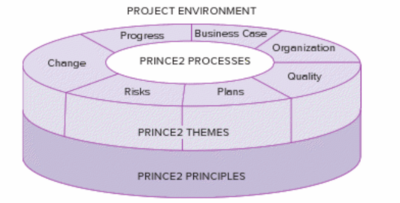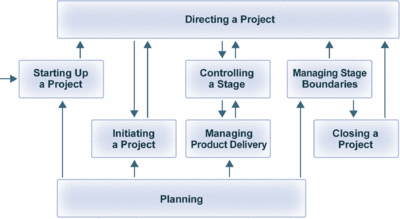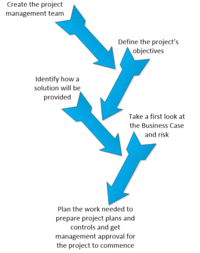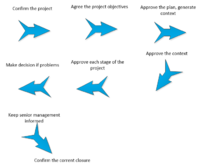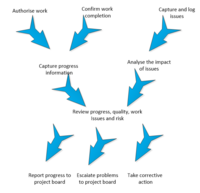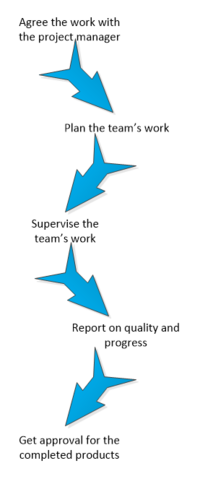PRINCE2, A Project Management Methodology
(→The Benefits of PRINCE2) |
(→Disadvantage and Limitations of PRINCE2) |
||
| Line 182: | Line 182: | ||
* Divide projects into manageable stages in order to make the goals achievable | * Divide projects into manageable stages in order to make the goals achievable | ||
| − | = | + | = Limitations of PRINCE2 = |
| + | As described throughout this article, PRINCE2 is the most popular tool (methodology) available for project management. Must organizations have already implemented this methodology and others are implementing it for the first time. As there are advantages and benefits within this methodology, there are also limitations to PRINCE2. Here are some points to be aware of while implementing PRINCE2 methodology for the first time. | ||
| + | |||
| + | * Everyone involved in a project life cycle should be trained in PRINCE2 | ||
| + | * Begin small and develop more, once the methodology is accepted in the organization | ||
| + | * Learn from experienced employees, employ people who have experience with the methodology | ||
| + | ******************* | ||
= Scalability = | = Scalability = | ||
Revision as of 17:35, 16 September 2015
Project management is a discipline that is indispensable and rapidly expanding as organizations are becoming more globalized. To implement new strategies and products, an organization needs to select project managers, however by selecting a project manager and a team, an organization is not guaranteed successful project outcomes.
In past years different methodologies have been developed to help organizations consider all the necessary components of project management, for example, planning, controlling, communication and finalization of projects. One of the widely used project management methodologies is the PRINCE2 method, this methodology is based on seven principles, eight Processes and seven themes, which will be described in this article. While this article is going to be used publicly, it is also important to know other properties of this methodology, for example, scalability and Benefits.[1][2]
Contents |
PRINCE2
PRINCE (PRoject IN Controlled Environments) is a structured method for effective and efficient project management. The method was developed from an exiting method PROMPTII, which was developed by Simpact Systems Ltd in 1975. In 1979 PROMPTII was adopted by CCTA (The Central Computer and Telecommunications Agency) in UK as the standard for all government projects, mainly for IS (Information Systems) projects. In 1989 Superseded PRINCE the exiting method PROMPTII within government projects.
CCTA continued developing the method and in 1996 launched PRINCE2 in response to user requirements for improved guidance on project management on all projects, not only IS projects. PRINCE2 is based on experiences of European project managements and project teams, who have contributed, some from their successes and others from their mistakes and omissions. [3][4][5][6][2][7]
Overview of the Method
PRINCE2 is a process-driven project management methodology. This method is based on three elements. The principles, the processes and the themes, these elements are shown on figure 1.
The Principles are: Business Justification, Learn from Experience, Roles and Responsibilities, Manage by Stages, Manage by Exception, Focus on Products and Tailor to Suit the Environment, these are described in details later in the article.
The Processes are: Starting Up a Project (SU), Directing a Project (DP), Initiating a Project (IP), Managing Stage Boundaries (SB), Controlling a Stage (CS), Managing Product Delivery (MP), Closing a Project (CP) and Planning (PL), these are described in more details later in the article.
The Themes are: Business Case, Organization, Quality, Plans, Risk, Change and Progress, these are described in more details later in the article.[2][3][7]
Overview of Principles
The first integrated element of PRINCE2 is, the Principles. You can think of this element us a core concept that the rest of PRINCE2 method adheres to. The seven principles are described in details below.
Business Justification
The first principle of PRINCE2 method is Business Justification. The aim of this principle is to ensure, that this important question is answered "Why are we doing this project?". The answer to this question is outlined in the project Business Case. The Business Case is a important document, which is continuously updated throughout the entire project and if the Business Case is not available any more, the project is closed. This principle also ensures that the resources allocated to the project is not wasted. [8][2][3]
Learn from Experience
The second principle of PRINCE2 method is to Learn from Experience. Every project is unique and this uniqueness leads to risk and challenges. The goal is to avoid what didn't work in the past and implement what did work. The project team should learn from previous projects through log reviewing, so they can be able to avoid the same mistakes.[8][2][3]
Roles and Responsibilities
The third principle of PRINCE2 method is define Roles and Responsibilities. The primary goal for this principle is to ensure only the right people are involved in the project. Any times people from different departments are involved in a project, which can lead to conflicts of interests and competing objectives, this may impede the progress of the project. In order to avoid conflict, fully defined structure with required people need to be in place. The roles should be clear, everyone should know the nature of their involvements, and what they are responsible for.[8][2][3]
Manage by Stages
The forth principle of PRINCE2 method is Manage by Stages. This principle aims to break the project into manageable and workable chunks. A project manager should have a long term plan and a short term plan, the short term plan is more detailed, a detailed short term plan should be developed after the previous short term plans are completed and assessed by project board.[8]
Manage by Exception
The fifth principle of PRINCE2 method is Manage by Exception. The aim of this principle is to require establishment of tolerances against six variables including: Time, Cost, Quality, Scope, Risk and Benefit. If the forecast exceed any of the six, this principle ensures that decisions are taken at the right place and time.[8][2][3]
Focus on Products
The sixth principle of PRINCE2 method is Focus on Products. The aim of this principle is to ensure that a product description is created at the beginning of the project, and that there is clarity and a common understand of, what the project will produce. This principle provides safeguard to increase the likelihood, that stakeholder exceptions are meet in terms of output and in terms of quality.[8][2][3]
Tailor to Suit the Environment
The seventh principle of PRINCE2 method is Tailor to Suit the Environment. This principle helps to avoid two common extremes: The wild-west approach, where there is basically to structure in place for the management of projects, and a rigid methodology which is blindly adhered to every detail. This principle ensures a balanced approach to fit each organization, no matter the size, environment, complexity and risk of the project.[8][2][3]
Overview of Processes
The second integrated element of PRINCE2 is, the eight Processes. See the PRINCE2 Processes Overview shown in Figure 2. All of the processes shown of figure 1 provides sets of activities showing, how to manage different parts of the project. The Processes cover activities from tarting of a project, through controlling, planning and closing of the project. Each Processes covers a specific task and time during the project. The Processes are described in detail below.
Starting up a Project (SU)
The first process within a PRINCE2 project is SU (Starting Up a Project). There are two types of projects within an organization, a project that can stand alone or a project that is part of a program, in case of the last one, a program manager can start a project within his existing project team and in case of the first one, a project can only be triggered by a program manager or by issuing a Project Mandate. A Project Mandate is a document containing sufficient information about the project, for example why the project is important for the organization. In order to start a project, a senior project manager or board of directors should give approval to the project. [9][2][3]
Developing a detailed plan for a project takes allot of resources, and as a first step SU can be also used as a filter, filtering good projects from the bad one, those bad projects that should not even be started in the first place. Figure 3. Starting up a Project Overview, shows the steps that should take place before starting a PRINCE2 project.
Key points in this process are:
- Creating the project management team
- Define th project objectives
- Identify how a solution will be provided
- Take a first look at the business case and risk
- Plan the work needed and get the management approval to start the project.
Directing a Project (DP)
The second process within a PRINCE2 project is DP (Directing a Project). This process is used by the project board to provide direction and authorization to the project at key stages. This also enables the project board to be accountable for the project's success. The project board delegate day-to-day management of the project to the project manager, releasing the project to project manager one stage at a time. Figure 4, Directing a Project Overview, shows how the second process is formed and can be implemented. [10][2][3]
Key points in this process are:
- Confirm the project
- Agree the project objectives
- Approve the plan, generate context
- Approve the context
- Approve each stage of the project
- Make decision if problems
- Keep senior management informed
- Confirm the current closure
Initiating a Project (IP)
The third process within a PRINCE2 project is IP (Initiating a Project). IP is mainly about project plan and setting up the roles (strategies) and establish solid foundation for the project. IP enables the organization to understand, that this project needs to be done. [11][2][3]
Key points in this process are:
- Prepare the risk management strategy
- Set up project controls
- Prepare the quality management strategy
- Create the project plan
- Refine the business case.
Managing Stage Boundaries (SB)
The fourth process within a PRINCE2 project is SB (Managing Stage Boundaries). This process ensures that the project is divided into manageable stages, so that the project board better can review the project progress. The purpose of SB for the project manager is to prepare the next stage of the project and provide relevant and accurate information to the project board, so that the decision for project continuation can be taken. [2][3]
Key points in this process are:
- Plan the next stage
- Update the project plan
- Update the business case
- Report stage end
- Produce an exception plan
Controlling a Stage (CS)
The fifth process within a PRINCE2 project is CS (Controlling a Stage). This process describes the activities of the project manager, within each stage of the project, it also specifies the way in which progress should be monitored and how the highlights of the progress should be reported to the project board. A project manager should provide accurate information to the project board, so the correct actions can be taken. Figure 5 Controlling a Stage, shows the steps in this process. [2][3]
Key points in this process are:
- Authorize a work package
- Review work package
- Review completed work package
- Review stage
- Report highlights
- Report Issues
- Risk management
- Take corrective action
Managing Product Delivery (MP)
The sixth process within a PRINCE2 project is MP (Managing Product Delivery). This process has the purpose of controlling the link between the project manager and the team manager(s), by placing the formal requirements on accepting, executing and delivering project work. The role of the team manager(s) are to coordinate an area of work that delivers one or more of the products. Figure 5. Managing Product Delivery, shows the work flow of this process. [2][3]
Key points in this process are:
- Agree on work with project manager
- Plan team's work
- Supervise
- Report quality
- Get approval of project board
Closing a Project (CP)
The seventh process within a PRINCE2 project is CP (Closing a Project). This process covers things that should be done at the end of a project. The project be formally de-commessioned and the resources should be reallocated to other projects. The project manager should make sure that the products are delivered and approved, and the team is prepared to deal with the unresolved issues and risks. [2][3]
Key points in this process are:
- Prepare planned closure
- Hand over products / results
- Evaluation
- Recommendation
Planning (PL)
The eighth process within a PRINCE2 project is PL (Planning). This process describes how to plan effectively. Every project relies in an effective planning and control process, even if the project is very small, it require planning. Planning process provides the project team with important information, for example, what is required, how it will be achieved and by whom and when, using what specialized equipment ect. In PL the technique of product-based planning is used, it is a comprehensive planning method that enables the project managers to control progress, it provides a description of product requirements, which skills needed, quality and other requirements in order to developed a product that is within the required tolerances. [2][3]
Overview of Themes
The third integrated element of PRINCE2 is the themes. The themes describe how PRINCE2 recommends to carry out various aspects of project management. For example, the risk themes recommends how to manage risk in a project. Each of the themes may be useful throughout all the processes described above in Overview of Processes.[2][3]
Business Case
The business case theme describes how to ensure the project have a solid and justified reason to exist.
Organization
The organization theme defines the structure of the project team. It describes the various roles within the structure and sets out their responsibilities.
Quality
The quality theme describes how to ensure that the project products are fit for the purpose for which they will be used.
Plans
The plans theme describes how to plan and what products to create and what activities are needed to build the products.
Risk
The risk theme describes how to manage providential threats and opportunity in the project.
Change
The change theme describes how to manage change in the project.
Progress
The progress theme describes how to track progress in the project and how to manage it in order to keep the project on track.
The Benefits of PRINCE2
A good project management method will guide the project through a controlled, well-managed and visible sets of activities to archive organization goals. Organizations are aware of the benefits a project management method can bring, and some of the benefits are [2][3]:
- A repeatable method
- A structured method
- Building on experience
- Ensuring that everyone knows what to expect, where, how and when
- Early warning of problems
Sometimes projects are related to each other or they are a part of a larger program an organization is managing, in all these situations the PRINCE2 method is applicable, it can provide the organization with:
- Active involvement of users and stakeholders in the project
- Controlled management of resources
- Controlled management of risks
- focused on goal of the project, what the project is delivering, why and by whom
PRINCE2 provide the project with:
- Organized start, middle and end of a project
- Regular reviews of the progress
- Good communication between project management team and organization
Project managers are able to:
- Keep meetings in the vital points of the project
- Provide brief reporting about the project
- Divide projects into manageable stages in order to make the goals achievable
Limitations of PRINCE2
As described throughout this article, PRINCE2 is the most popular tool (methodology) available for project management. Must organizations have already implemented this methodology and others are implementing it for the first time. As there are advantages and benefits within this methodology, there are also limitations to PRINCE2. Here are some points to be aware of while implementing PRINCE2 methodology for the first time.
- Everyone involved in a project life cycle should be trained in PRINCE2
- Begin small and develop more, once the methodology is accepted in the organization
- Learn from experienced employees, employ people who have experience with the methodology
Scalability
Project management is a complex discipline and it will be wrong to assume, that a blind application of PRINCE2 methodology will result in a successful project. It will also be wrong to assume, that all PRINCE2 elements are applicable to every project, for this reason every process has its own note on scalability, and this provide guidelines, so it is clear for the project manager which elements of PRINCE2 is applicable in his situation. The positive aspects of this methodology is, that it can be tailored to particular needs of every project. [7]
References
- ↑ Project Management Methodologies: A Review of the Literature, PM, 15-sep-2015, Liberty University
- ↑ 2.00 2.01 2.02 2.03 2.04 2.05 2.06 2.07 2.08 2.09 2.10 2.11 2.12 2.13 2.14 2.15 2.16 2.17 2.18 [Book] PRINCE2 Study guide, by Hinde and David, Mar-2012, Publisher wiley,
- ↑ 3.00 3.01 3.02 3.03 3.04 3.05 3.06 3.07 3.08 3.09 3.10 3.11 3.12 3.13 3.14 3.15 3.16 3.17 [Book] Managing Successful Projects with PRINCE2, 2005 Edition, Published by TSO
- ↑ PRINCE2 in One Thousand Words, 14-sep-2015, http://www.best-management-practice.com/gempdf/PRINCE2_in_One_Thousand_Words.pdf
- ↑ PRINCE2 Methodology: An Innovative Technique, 14-sep-2015, http://cgr.umt.edu.pk/icobm2013/papers/Papers/IC3-Jan-2013-049.pdf
- ↑ Implementing PRINCE2 Project Management Methodology, 14-sep-2015, https://www.projectsmart.co.uk/implementing-prince2-project-management-methodology.php
- ↑ 7.0 7.1 7.2 PRINCE2 Wikipidia, 14-sep-2015, https://en.wikipedia.org/wiki/PRINCE2
- ↑ 8.0 8.1 8.2 8.3 8.4 8.5 8.6 The Seven Principles defined in PRINCE2, 18-nov-2015 ,http://thinketg.com/the-seven-principles-defined-in-prince2/
- ↑ PRINCE2 Learner Site, 15-sep-2015,http://www.prince2primer.com/prince2-starting-up-a-project-process
- ↑ PRINCE2, Learner Site, 14-sep-2015, http://www.prince2primer.com/directing-a-project
- ↑ PRINCE2, Learner Site, 15-sep-2015, http://www.prince2how2.com/p/prince2initiating-project-ip.html
